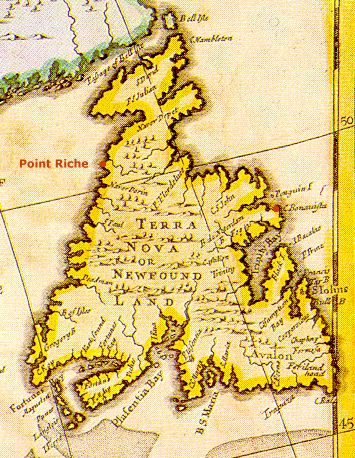NL GenWeb
Historical Information
West Coast - Bay of Islands
Treaty of Utrecht, 11 April 1713
To prevent the close cooperation, if not the amalgamation, of France and Spain on the death of Charles II of Spain (1 Nov. 1700), the Grand Alliance declared war on France (4 May 1702). This war was to become known as:
Queen Anne's War: War of the Spanish Succession 1702-1713
and it came to affect Newfoundland.

In 1705, Fort William in St. John's was beseiged by 600 French troops under Auger de Subercase. However, John Moody with 50 -60 men defeated the French who had losses of 200 men. The French however, capture Bay Bulls and Petty Harbour. French raiders also attacked and sacked settlements of Trinity and Bonavista.
In 1708, the French from Placentia under Sainte Ovide de Brouillon Mombeton attacked St. John's December 22 and took it with little resistance. They completely destroyed St. John's and all guns and equipment were taken to Placentia, along with the entire garrison as prisoners. This brought the eastern shore of Newfoundland effectively under French control.
At the end of the War, by the Treaty of Utrecht (11 Apr. 1713) Newfoundland, Acadia, and Hudson Bay were ceded to Great Britain, but France retained Cape Breton Island and the islands of St. Lawrence.
There had always been friction with the French in North America, and Newfoundland was no exception. The Treaty of Utrecht (1713) was designed to resolve some of these problems, which internationally it probably did, but unfortunately it simultaneously confirmed the process which restricted Newfoundland's development for the next 200 years.
"But it shall be allowable to the subjects of France, to catch fish, and to dry them on land, in that part only, and in no other bodies bodies that, of the said island of Newfoundland, which stretches from the place called Cape Bonavista, to the northern point of the said island, from thence running down by the western side, reaches as far as the place called Pointe Riche."Under its terms the British maintained control of Newfoundland, but the French were accorded inshore fishing rights on a section of coastline from Bonavista northwards through the Straits of Belle Isle and southwards along the west coast to Point Riche near Port aux Choix. This was roughly half the Island's coastline on which English settlers (Newfoundlanders) would not be permitted to live.Article 13, Treaty of Utrecht (1713) [End of the War of Spanish Succession]

NL Map Circa 1719 ~ Red Marks Mine
Bay of Islands District